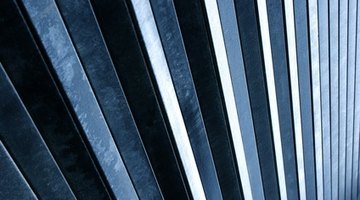Florida Building Code Requirements for Shutters
Because of the high frequency of hurricanes in Florida, it's common practice to equip windows and glazed surfaces with strong protective shutters. While there aren't any state building codes to regulate the general use of decorative or functional shutters, all specially designed hurricane shutters must comply with the Florida building code.
High Velocity Hurricane Zone

In Florida's Broward and Miami-Dade counties, the Florida Building Code applies special regulations, identifying the area as a "high velocity hurricane aone." Within this zone, all glass surfaces, including windows and doors, must be covered by storm shutters. The only exceptions are those glazed exterior elements that can withstand the same impact levels as shutters. You may use either permanently anchored shutters or removable models. In either case, shutters must bear the seal of a qualified designer, either an engineer or architect. In addition, all elements of the shutters must meet Florida's product control.
Shutter Dimensions
Outside of the high velocity hurricane aone, homeowners may decide whether or not to secure their windows with storm shutters. As within Miami-Dade counties, homeowners should only use storm shutters designed and manufactured by qualified engineers and bearing their manufacturer's seal on all components. While temporary, homemade emergency shutters, such as simple sheets of plywood, may limit hurricane damage, they do not comply with Florida Code.
Whether purchasing or producing your own shutters, ensure they adequately cover and protect glazed surfaces. Shutters shouldn't attach to glass windows directly, but should fit over them with a gap of 1 inch of space or more. This minimum space should hold at the point of greatest deflection, when the shutters are withstanding maximum strength winds. The shutter should ideally be flush with the wall, with a maximum gap between them of 1/4 inches.
Shutter Testing
By legal requirement within the high velocity hurricane zone, and optionally throughout the state, storm shutters must withstand a battery of impact tests. The missile test, designed to emulate flying debris, consists of applying a 9-lb., 2-by-4 inch piece of lumber to a shutter at 50 miles per hour. A secondary impact test uses multiple small, steel balls weighing 2 grams each and measuring 5/16 inches in diameter. These balls strike at 130 miles per hour. In another test, designed to resemble hurricane-strength winds, even pressure is exerted upon the entire surface of the shutter.
References
Writer Bio
Danielle Hill has been writing, editing and translating since 2005. She has contributed to "Globe Pequot" Barcelona travel guide, "Gulfshore Business Magazine," "Connecting Lines: New Poetry from Mexico" and "The Barcelona Review." She has trained in neuro-linguistic programming and holds a Bachelor of Arts in comparative literature and literary translation from Brown University.
Photo Credits
- abstract lines image by Scott Liddell from Fotolia.com
More Articles



